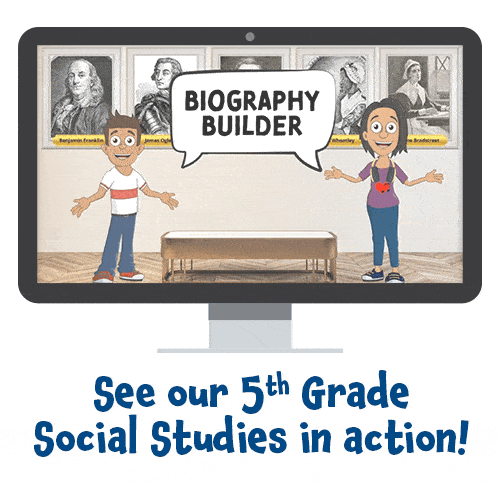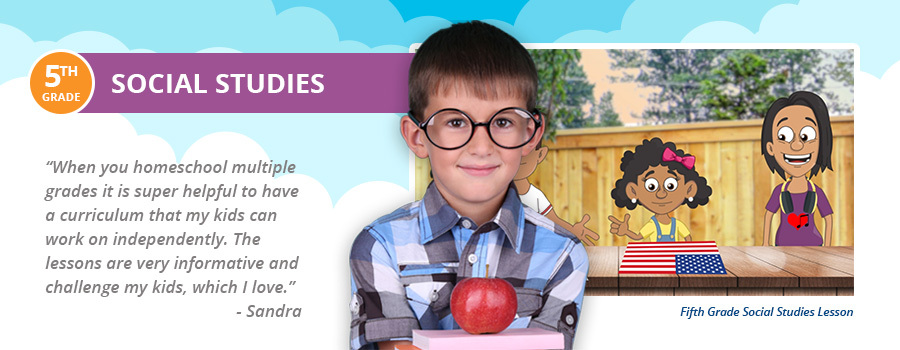Fifth Grade Homeschool Social Studies Curriculum
A well-designed Grade 5 Social Studies curriculum not only imparts factual knowledge but also cultivates your student’s
critical thinking skills. In Grade 5, students take an in-depth look at American History to better understand the
motivations, challenges, and successes of America’s past.
The Time4Learning Grade 5 Social Studies course covers:
- Pre-Colonial America
- 13 Colonies
- Revolutionary War
- The US Constitution
- Westward Expansion
What Makes the T4L Social Studies Curriculum Unique?
Time4Learning offers a dynamic learning experience designed to transform traditional Social Studies education. Students
engage with each topic through the lens of a compelling question. This compelling question challenges students to
analyze the people, events, and outcomes of American History as they form their own opinions.
The course offers a variety of content features to create an engaging learning experience from start to finish.
Grade 5 Social Studies content features our T4L families love:
- roadschooling family traveling across the US to important historical locations
- interactive timelines
- lessons include videos, literature, and primary and secondary source documents
- biography study and capstone project
- offline extension activities
Time4Learning’s Social Studies Lessons
Students will explore the history and values connected to American symbols.
Students will explore the tools they will use to organize their leaning and construct strong arguments.
Students will investigate the cooperation and conflict that existed among the American Indians and between the Indian nations and the new settlers. This will help them answer the chapter’s compelling question.
Students will explore the lifeways of the Sault Tribe of Chippewa in Sault Ste. Marie, Michigan, and the Timucua in Florida. This will help them answer the lesson’s supporting question.
Students will investigate early French and Spanish settlements and the interactions between the colonists and Indigenous peoples. This will help them answer the lesson’s supporting question.
Students will describe the cooperation and conflict that existed between the Pilgrims and the Wampanoag and Nausets. They will also examine the conflicts that led to King Philip’s War. This will help them answer the lesson’s supporting question.
Students will review their KWL and use the evidence they’ve gathered to complete a final task related to the chapter’s compelling question. They will also answer multiple choice questions to check their understanding of the material covered within the chapter.
Students are given an opportunity to extend their learning by completing additional activities related to the topics of the chapter.
Students will be introduced to the three regions of the thirteen British colonies: Southern Colonies, New England Colonies, and Middle Colonies as they explore the economic and religious motivations of the colonists. This will help students answer the chapter’s compelling question.
Students will explore religious motivations for colonization in Maryland and the practices of large-scale agriculture and slavery throughout the South. This will help them answer the lesson’s supporting question.
Students will learn about religious motivations for colonization and explore primary sources related to the colonial shipping industry in the New England Colonies. This will help them answer the lesson’s supporting question.
Students will learn about the economic factors of living in large and diverse colonial cities. This will help them answer the lesson’s supporting question.
Students will review their KWL and use the evidence they’ve gathered to complete a final task related to the chapter’s compelling question. They will also answer multiple choice questions to check their understanding of the material covered within the chapter.
Students are given an opportunity to extend their learning by completing additional activities related to the topics of the chapter.
Students will compare the daily lives of men, women, and children who lived in the British colonies to life today. This will help them answer the chapter’s compelling question.
Students will explain everyday life in the British colonies. This will help them answer the lesson’s supporting question.
Students will identify different jobs done by colonial men and women. This will help them answer the lesson’s supporting question.
Students will describe the daily lives of colonial children, apprentices, and servants. This will help them answer the lesson’s supporting question.
Students will review their KWL and use the evidence they’ve gathered to complete a final task related to the chapter’s compelling question. They will also answer multiple choice questions to check their understanding of the material covered within the chapter.
Students are given an opportunity to extend their learning by completing additional activities related to the topics of the chapter.
Students will the roles of the colonists and the British Crown and government in ruling the colonies over time. This will help them answer the chapter’s compelling question.
Students will explore the relationship between the colonies and Great Britain just before the American Revolution. This will help them answer the lesson’s supporting question.
Students will learn about ways the colonists came together and organized against the policies they disagreed with. This will help them answer the lesson’s supporting question.
Students will learn how the conflict between the British and the colonists escalated. This will help them answer the lesson’s supporting question.
Students will review their KWL and use the evidence they’ve gathered to complete a final task related to the chapter’s compelling question. They will also answer multiple choice questions to check their understanding of the material covered within the chapter.
Students are given an opportunity to extend their learning by completing additional activities related to the topics of the chapter.
Students will explore events of the American Revolution as they consider the question “Can one event change history?”
Students will compare the perspectives of people in the colonies during the American Revolution.
Students will learn about the Battles of Saratoga and the allies who fought with the Americans and the British to summarize how the outcome of these battles was a turning point in the war.
Students will relate the outcome of the Battle of Yorktown to the establishment of a new nation.
Students will review their KWL and use the evidence they’ve gathered to complete a final task related to the chapter’s compelling question. They will also answer multiple choice questions to check their understanding of the material covered within the chapter.
Students are given an opportunity to extend their learning by completing additional activities related to the topics of the chapter.
Students will explore the idea that soldiers were not the only people involved in the American Revolution.
Students will explore the roles women and children played during the war.
Students will learn about people who allied with the Continental Army.
Students will compare the roles of military leaders, spies, and diplomats in the war.
Students will review their KWL and use the evidence they’ve gathered to complete a final task related to the chapter’s compelling question. They will also answer multiple choice questions to check their understanding of the material covered within the chapter.
Students will extend their learning by completing additional activities related to the topics of the chapter.
Students will explore key questons about the new United States to build background about the US Constitution.
Students will investigate the Articles of Confederation, Shays’ Rebellion, and the plan for a new form of federal government.
Students will learn about the balance of power and responsibilities and checks and balances in the federal government.
Students will explore the concept of compromise and explore compromises the framers of the Constitution made.
Students will review their KWL and use the evidence they’ve gathered to complete a final task related to the chapter’s compelling question. They will also answer multiple choice questions to check their understanding of the material covered within the chapter.
Students will extend their learning by completing additional activities related to the topics of the chapter.
Students will be introduced to the Bill of Rights and to important rules and laws that influence its creation.
Students will begin by investigating the purpose of the first ten amendments to the US Constitution and discover how Congress decided to include the Bill of Rights as a governing document.
Students will learn about the specific amendments included in the Bill of Rights and onsider why former colonists and members of Congress considered the amendments in the Bill of Rights necessary.
Students will summarize the role of the Bill of Rights in their lives today and examine the role of the Supreme Court in upholding First Amendment rights.
Students will review their KWL and use the evidence they’ve gathered to complete a final task related to the chapter’s compelling question. They will also answer multiple choice questions to check their understanding of the material covered within the chapter.
Students will extend their learning by completing additional activities related to the topics of the chapter.
Students will consider land policies and planning from colonial times through the early expansion of the United States.
Students will explore the culture and traditions of the Indigenous nations that lived in the region as they consider the question “How did people live in the West before the Louisiana Purchase?
Students will learn about the Corps of Discovery’s expedition and find answers to the question “What happened after the Louisiana Purchase?
Students will compare how different states were added to the union to answer the question “How did the process of making new states impact the United States?”
Students will review their KWL and use the evidence they’ve gathered to complete a final task related to the chapter’s compelling question. They will also answer multiple choice questions to check their understanding of the material covered within the chapter.
Students will extend their learning by completing additional activities related to the topics of the chapter.
Students will explore a map that shows major additions to land in the United States in the 19th century.
Students will begin by investigating the philosophy behind Manifest Destiny and how disputes over land led to suffering for the Cherokee people.
Students will learn about wagon trails to the West and consider the difficulties faced by settlers and their motivations for migrating west.
Students will examine primary sources that show depictions of icons from the American West to find what they can teach us about life in the 1800s.
Students will review their KWL and use the evidence they’ve gathered to complete a final task related to the chapter’s compelling question. They will also answer multiple choice questions to check their understanding of the material covered within the chapter.
Students will extend their learning by completing additional activities related to the topics of the chapter.
Students will begin by selecting a historical figure to research and filling out a biography builder with basic information about them.
Students will collect information about their subject. They will learn how to identify and cite reliable print or internet sources and make a list of sources they will use for their report. They will make notes from the sources they select using key questions to group information.
Students will draft, revise, edit, and publish their biography. A final checklist for students will help them catch aspects that need polishing. Parents may use the checklist to grade the project..
Students will design a presentation to share information about the historical figure they chose. They will prepare visuals and speaker notes, and practice good presentation habits as they share what they have learned.
Scope & Sequence Copyright © 2025 Edgenuity, Inc. All rights reserved.








